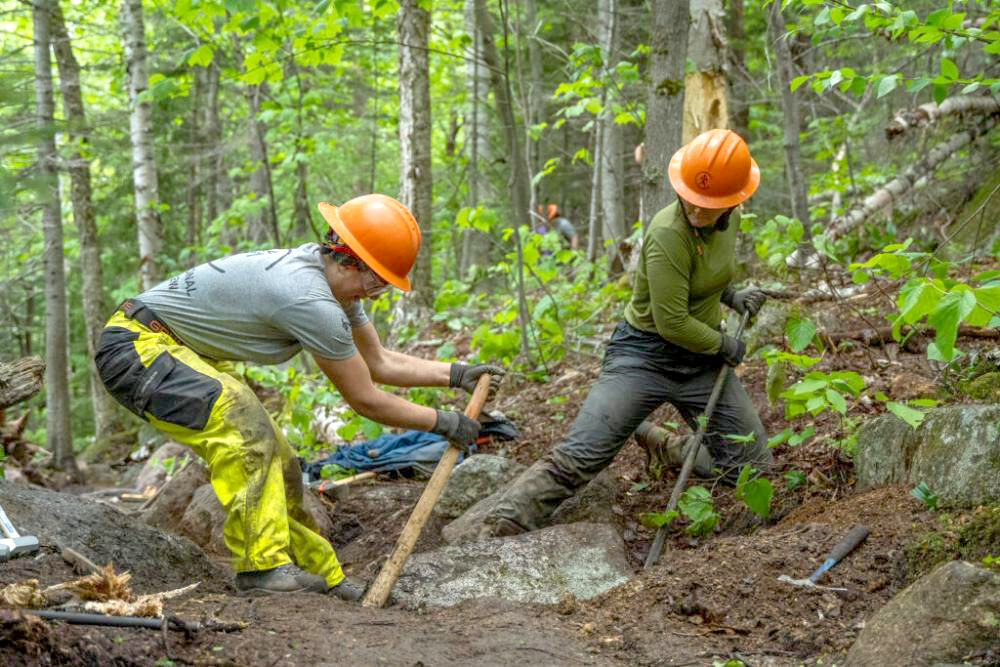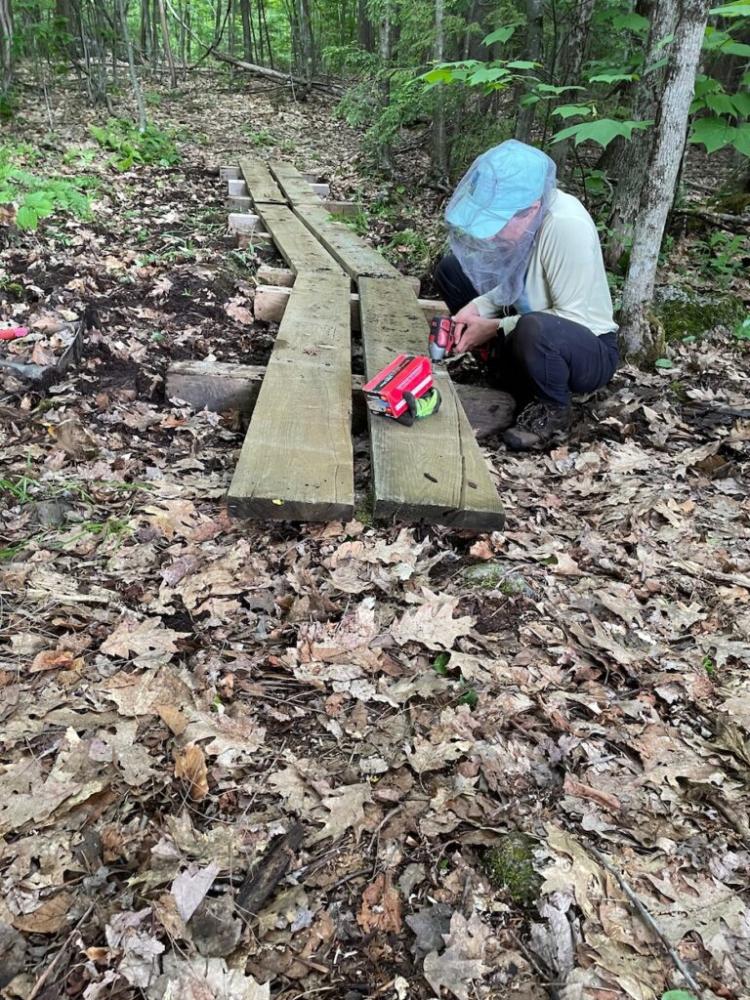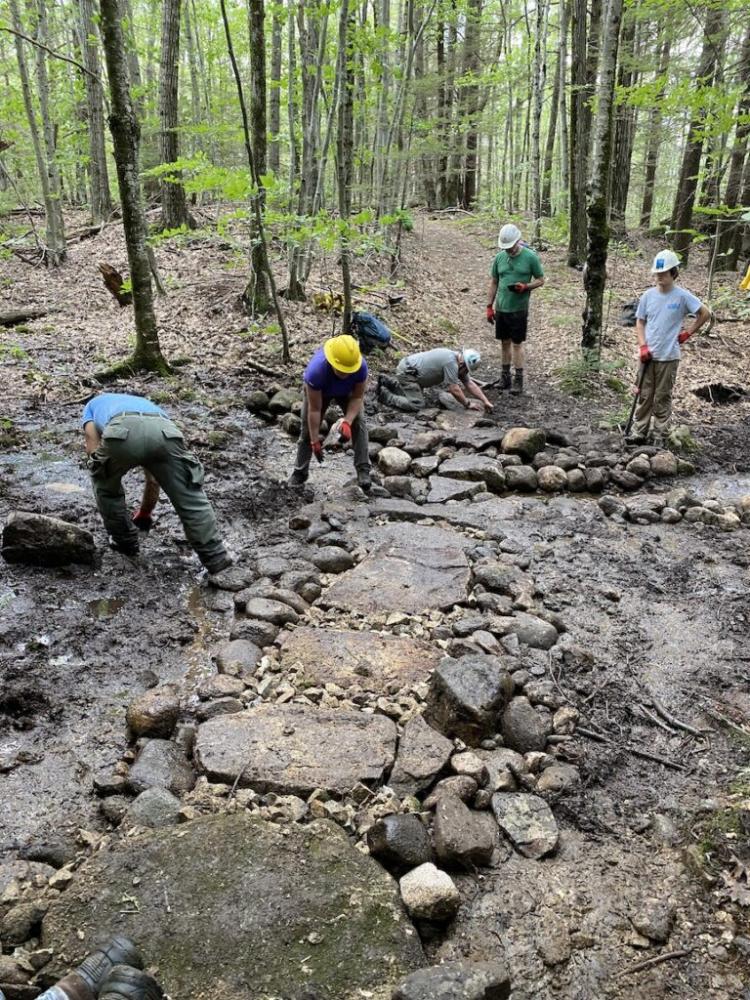 Appalachian Mountain Club crew members set a rock for a staircase on the Old Bridle Path trail, part of the multi-year Franconia Loop trail restoration project. (Courtesy or Robin Lemmerz)
Appalachian Mountain Club crew members set a rock for a staircase on the Old Bridle Path trail, part of the multi-year Franconia Loop trail restoration project. (Courtesy or Robin Lemmerz)
This summer, millions of tourists will make their mark on the thousands of miles of trails New Hampshire has to offer. What they may not know is that hundreds of mostly volunteer trail workers around the state make their hiking adventures possible.
“There are so many different organizations that help with trails and trail maintenance in the state; it’s really a big patchwork,” said Carrie Deegan, reservation stewardship and engagement director with the Society for the Protection of New Hampshire Forests.
The Forest Society oversees 200 properties in the state, including most of Mount Major and Mount Monadnock. New Hampshire’s Department of Natural and Cultural Resources and the U.S. Forest Service jointly manage the public lands of the White Mountains, in partnership with nonprofit and volunteer organizations like the Appalachian Mountain Club and the Randolph Mountain Club. These largely volunteer-led organizations maintain specific trails with staff and volunteers.
As part of these various groups, staff and volunteer workers play a significant role in the stewardship and maintenance of trails throughout the state. Their efforts combat erosion, flooding, and other wear-and-tear trails endure from weather or use. This tourist season, heavy rainfall has strained maintenance work.
 A Forest Society member constructs bog bridging on the Welch Family Farm and Forest in Hancock. (Courtesy)
A Forest Society member constructs bog bridging on the Welch Family Farm and Forest in Hancock. (Courtesy)
Summer rainfall creates maintenance challenges
“This summer, we’ve had an incredible amount of rain, which has really been challenging,” Deegan said.
The rainfall means some trails are much wetter than usual and others are inaccessible due to swollen streams. Alex DeLucia, director of trails at the Appalachian Mountain Club, said hiker safety is his greatest concern. He emphasized that hikers should plan carefully in light of weather and trail conditions.
Some trails have also faced high levels of erosion due to the rainfall. According to Deegan, there are several tactics trail workers can use to address wet trails and keep them accessible.
If a trail appears that it will remain very wet in the long term, they might try to install a walking surface above, such as stepping stones or bog bridging, a simple bridge made from wooden boards and logs. Another alternative is a gravel turnpike: a raised gravel surface with drainage underneath.
Much of regular trail work also goes toward preventing the erosion that might occur during intense rainstorms.
“This is really the challenge that every trail maintenance worker has,” Deegan said. “Water is not a friend of trails, and so we try to get the water off the trail as quickly as we can.”
In order to divert water off of trails and prevent further erosion, workers might install water bars, a series of rocks or timberwood laid diagonally across the trail, Deegan said. When water hits the bar, it is directed off of the trail and into surrounding vegetation. Workers can also install check steps, a series of rock or wooden steps that are intended to slow the water flow as it runs down the mountain.
“This is sort of a last ditch just to slow the water down because the faster the water is moving, the more soil it can carry with it,” Deegan said.
NH trails not built to last
In other regions of the country, hiking trails are created with switchbacks: zig-zags in the hiking path that make traveling steep terrain easier and safer. However, Deegan explained that most trails in New Hampshire are not built this way.
“Our trails tend to go straight up the fall line, which basically means directly up the mountain, and so that is not the greatest way to lay out a trail,” she said.
When there is heavy rainfall or flooding, water will travel the path of least resistance down the trail, carrying debris and soil with it. Once a trail erodes past ground level, it can be very difficult to repair.
“These are old trails that were built before there was any real understanding of erosion,” DeLucia said. “But we know now, like we would never build the trails like that today if we had the opportunity to rebuild them completely.”
He added that there is a “perfect storm” of factors impacting New Hampshire hiking trails.
“We’ve got some of the highest use in the northeastern region,” he said. “We’ve also got some of the highest amounts of precipitation in the Northeast and then the White Mountain region generally just has very thin soils, and so we add all of these things together … we’re talking about substantial soil loss, a lot of erosion happening, and a lot of impact on our trails, and so many trails are in need of substantial attention.”

Forest Society members install step stones to make an elevated walking surface on Marlboro Trail in 2021. (Courtesy)
Sometimes trails will be completely rehabilitated or rerouted because of the wear and tear they endure, or to address their steep, impractical structure. This fall, the Forest Society will construct a new trail to take the place of a portion of the existing main trail on Mount Major due to severe erosion.
At Franconia Notch, the Appalachian Mountain Club is completely rehabilitating portions of the Franconia Ridge trail loop that fall on federal land. The work will happen over the next five years, in partnership with the White Mountain National Forest, and a $1.1 million federal grant was given to fund the reconstruction. On state lands, the World Trails Network is working to restore the lower portions of the loop. These combined efforts will ensure the loop trails can better withstand their high volume of visitors and future severe weather.
How trail adoption supports maintenance
Both Deegan and DeLucia emphasize that routine trail maintenance is some of the most critical trail work, which is performed in large part by volunteers and trail adopters from various organizations.
“There’s just this constant level of maintenance that has to happen on the existing infrastructure on the trail,” Deegan said.
DeLucia describes routine maintenance as “the oil change of the trail,” which includes work like clearing off the trail path, maintaining drainage structures, and maintaining trail markers.
The White Mountain National Forest, the Forest Society, and the AMC offer trail adoption or land stewardship programs, where those hoping to give back can adopt a trail and take part in annual trail maintenance.
“These are opportunities for, you know, an individual or couples or family to adopt a segment of trail,” DeLucia said. “They receive a standardized training for free so they get some familiarity with what the expectations are and how to be safe out there. After their training, they get access to tools, safety equipment to do that basic maintenance work.”
Trail adoption is popular amongst those who can’t commit to volunteering for work days or events.
“So it really is an opportunity for folks to get as engaged as they want,” Deegan said. “It’s flexible, it’s on their own time, they don’t have to wait for a scheduled event to do the work.”
This story is courtesy of NH Bulletin under creative commons license. No changes have been made to the article.

 Current Issue - May 2024
Current Issue - May 2024